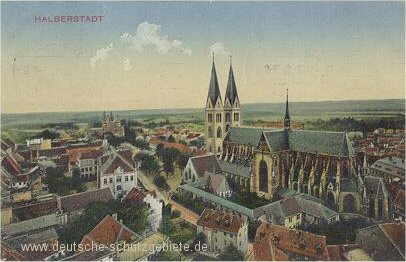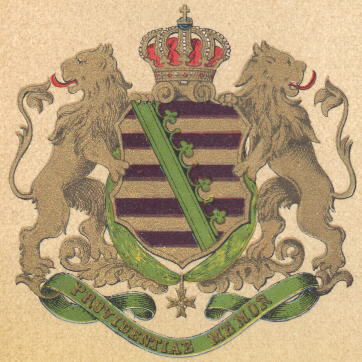1789 – Wilhelm Christoph Kelsch
Wilhelm Christoph Kelsch was born in 1789 to Christian Kelsch and Helene Henriette Marie Gloyer in Halberstadt, Königreich Sachsen. He was one two known births including a sister, Henriette Auguste Sabine Kelsch. We know nothing about his life except his marriage and some of his children.
1801 – Johanne Dorothee Friederike Schrader
Johanne Dorothee Friederike Schrader was born in 1801 to unknown parents in Halberstadt, Königreich Sachsen.
Halberstadt

Today, the city of Halberstadt is located in the German state of Saxony-Anhalt and is the capital of the Landkreis (district) of Halberstadt.
In 804, the Bishopric of Halberstadt was created by Charlemagne in an ongoing effort to Christianize the Saxon tribes. The bishop of Halberstadt was a prince of the Holy Roman Empire. The Prince Bishopric existed until the end of the Thirty Years’ War in 1648, when the territory was secularized and became part of Königreich Brandenburg-Preußen (the Kingdom of Brandenburg-Prussia).
The secular Princes of Halberstadt were the Prince/Electors of Brandenburg, who became the kings of Prussia and later the emperors of Germany.
In the 17th century, Halberstadt had one of the largest Jewish communities in central Europe. At the time, nearly one in twelve of the town’s inhabitants, almost 700 people, were Jewish.
During the Napoleonic wars, Halberstadt became part of the French-occupied Kingdom of Westfalen (in French, La Royaume de Westphalie), where it was the capital of the Departement of the Saale. In 1815, Halberstadt came under Prussian control, and in 1816 it became part of the Regierungsbezirk Magdeburg (Government District of Magdeburg) within the newly established Provinz Sachsen (Province of Saxony) in Königreich Preußen. At the same time the Landkreis (district) of Halberstadt was created.
Königreich Sachsen (the Kingdom of Saxony)
The Saxons were originally a small tribe living on the North Sea between the Elbe and Eider Rivers in today’s Holstein. Their name was derived from their stone knives called Sax.
In the third and fourth centuries, the Saxons pushed their way west into the region that is today Lower Saxony and northern North Rhine-Westphalia. They were followed by other tribes (Bavarians, Thuringians, Franks, and Frisians) which joined them in a large confederation. With the exceptions of the Saxons, all these confederations were ruled by kings. The Saxons were divided into a number of independent bodies under different chiefs, but in time of war they elected a duke to lead them. This confederation of tribes became collectively known as the Saxons. For centuries, the area was known as Saxony, and eventually as the Duchy of Saxony.
Beginning in 772 CE, Karl der Große (Charles the Great, or Charlemagne) conquered and eventually defeated the Saxons to expand the Frankish kingdom. In all, eighteen battles were fought in northwestern Germany during the thirty years of the Saxon Wars.
Charlemagne’s intent was the incorporation of Saxony into the Frankish realm and their conversion from paganism to Christianity. Frankish Catholic missionaries, along with others from Ireland and Anglo-Saxon England, attempted to convert the Saxons to Christianity with armed force. The Saxons resisted. Charles’ main Saxon opponent, Widukind, accepted baptism in 785 CE as part of a peace agreement, but other Saxon leaders continued to fight. Upon his victory in 787 CE at Verdun, Charles ordered the wholesale killing of thousands of pagan Saxon prisoners.

On Christmas Day, 800 CE, The Holy Roman Empire was founded with the coronation of Charlemagne by Pope Leo III. After several more uprisings, the Saxons suffered definitive defeat in 804 CE. Herzogtum Sachsen (the Duchy of Saxony) now became part of Heiliges Römisches Reich (the Holy Roman Empire) as an independent electorate—Kurfürstentum Sachsen (the Electorate of Saxony).
The empire was mainly a conglomeration of Germanic lands in Central Europe that lasted for 1,000 years, from 800 to 1806. From the late 15th century onwards, it was also known as Heiliges Römisches Reich Deutscher Nation (the Holy Roman Empire of the German Nation).
Following the abolition of the Holy Roman Empire in 1806 by Napoleon, Kurfürstentum Sachsen (the Electorate of Saxony) became Königreich Sachsen (the Kingdom of Saxony) by decree of the French Emperor. In 1871, after the end of the Franco-Prussian War, it became part of the newly-formed Deutsches Reich (the German Empire).
1827 – marriage and children
Wilhelm Christoph Kelsch and Johanne Dorothee Friederike Schrader were married on July 1, 1827 in Königreich Sachsen.
They had five children that we know about:
- Wilhelm Friedrich August Kelsch, born on February 16, 1831
- Ferdinand Wilhelm Julius Friedrich Kelsch, born on February 3, 1832
- Ludwig Heinrich August Christian Kelsch, born on February 14, 1834
- Amalie Kelsch, born about 1835
- Oscar David Friedrich Wilhelm Kelsch, born on December 29, 1842
Oscar David Friedrich Wilhelm Kelsch was baptized on January 29, 1842 at Hofkirche zu Unser Lieben Frauen zu Halberstadt (Court Church to Our Lady of Halberstadt) an Evangelisch-Reformierte Kirche (Evangelical Reformed Church).
Sometime around 1864, he was ordained in the Evangelical Reformed Church.
He married Anna Charlotte Caroline Wilcke on March 29, 1880 at the Evangelische Kirche Sophien (the Evangelical Church of Sophia), in Berlin, Königreich Preußen (the Kingdom of Prussia), in the Deutsches Reich (German Empire). (See Rev. Oscar Kelsch and Anna Wilcke.)
Deaths
We don’t know when Wilhelm Christoph Kelsch and Johanne Dorothee Friederike Schrader died, but they presumably died in Halberstadt, Provinz Sachsen, Königreich Preußen.